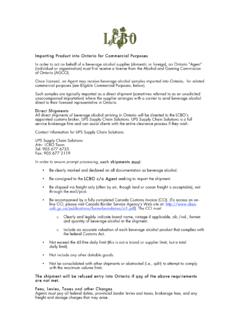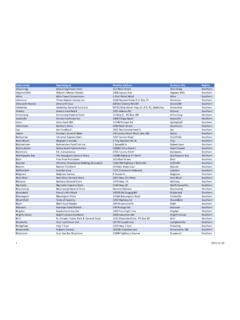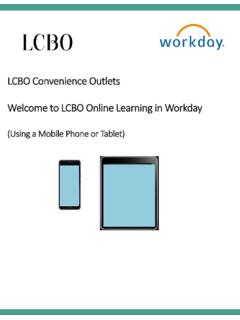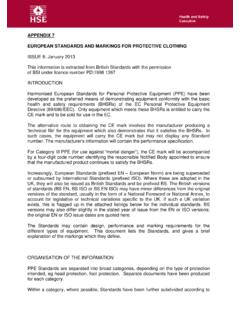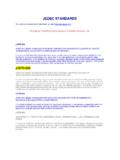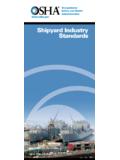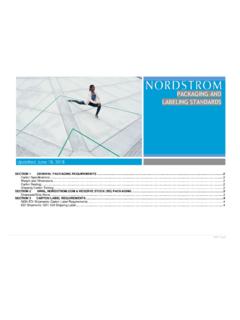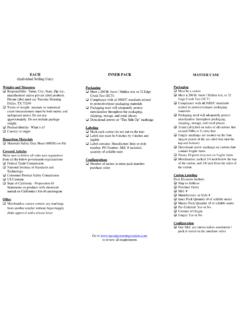Transcription of GUIDELINES FOR CHEMICAL ANALYSIS
1 0 PRODUCT PACKAGING standards GUIDELINES FOR CHEMICAL ANALYSIS -1- PRODUCT PACKAGING standards Shipping Container Markings Shipping Container Codes Shipping Container Design Specifications Trailers and Inter-Modal Containers Consumer Unit Labelling Requirements standards for Tamper-Evident Packaging QUALITY ASSURANCE LABORATORY GUIDELINES for CHEMICAL ANALYSIS Prepared by: Quality Assurance Department (ISO 17025 Accredited, 9001 Registered) Logistics & QA Division Toronto, Ontario, Canada Published March, 1998 Revision Date February 21, 2013 (see page 60 for a Summary of Document Revisions) - 2 - TABLE OF CONTENTS 1.
2 Shipping Container Markings General Information .. 6 Print Contrast Standard (PCS) .. 6 Dot Matrix or Ink Jet Printing .. 7 Description of Product on Shipping Containers .. 11 LCBO Number (formerly CSPC) .. 11 2. Shipping Container Codes (SCC-14) General Information .. 13 Symbol Format .. 13 Acceptable Bar Code Formats .. 14 Symbol Size, Location and Human Readable Characters .. 15 standards for Scannability .. 15 3. Shipping Container Design Specifications General Information .. 17 Wooden Cartons (Vintages Products Only) .. 17 Corrugated Fibreboard Cartons .. 18 Die Cut Handles.
3 19 Corrugated Fibreboard Trays .. 22 Shrink Wrap for Corrugated Fibreboard 24 Cans and PET Shipped in Trays .. 24 Glass Bottles Shipped in Trays .. 24 Multi-Pack Consumer Unit .. 24 Facings and Corrugating Mediums .. 25 Folds and Joints .. 26 Perforations and Zippers .. 26 Bottle Partitions & Head Space .. 26 4. Trailers and Inter- Modal Containers Trailers and Inter - Modal Containers .. 29 Loads Shipped In Trailers (Continental Highway Product) .. 29 - 3 - Loads Shipped In Inter - Modal Containers (Non-Continental Product) .. 30 Phytosanitary Requirements .. 33 Protective Services (Temperature Controlled Containers).
4 33 Pull Force Test Method for Measurement of Static Coefficient of Friction .. 34 5. Consumer Unit Labelling Requirements General Information .. 38 Allergen Alert .. 40 Nutritional Labelling & Claims .. 41 Gift Basket, Ornamental Containers Accessory Items and Other Labelling Requirements .. 41 Definitions .. 42 Product Date Coding .. 43 LCBO Number (formerly CSPC) .. 44 on Consumer Unit .. 44 Placement of on Consumer Unit .. 45 6. standards for Tamper-Evident Packaging Intent .. 49 Definitions .. 49 Kinds of Tampering .. 49 Acceptable Types of Tamper-Evident Packaging .. 49 7.
5 Quality Assurance GUIDELINES for CHEMICAL ANALYSIS 7. 1 CHEMICAL Testing GUIDELINES .. 51 Appendices Appendix A: ANSI Print Quality GUIDELINES .. 57 Appendix B: Terms and Definitions.. 59 Summary of Document Revisions Summary of Document Revisions.. 60 - 4 - INTRODUCTION The LCBO Product Packaging standards and GUIDELINES for CHEMICAL ANALYSIS is a document designed to assist suppliers in ensuring their products will meet minimum requirements for case markings, corrugated fibreboard packaging, trailer/container loading, consumer unit labelling and CHEMICAL composition when they arrive at the LCBO.
6 The document references standards and regulations from a variety of sources including but not limited to: the Canada Food and Drug Act and Regulations, the Canada Consumer Packaging and Labelling Act and Regulations, the CFIA Guide to Food Labelling and Advertising, the Ontario Liquor License Act and the CALJ - Product Identification standards for Use in the Distribution of Beverage Alcohol. While an attempt has been made to include all relevant requirements, space limitations do not allow for every possible requirement to be listed here and suppliers should consult the applicable regulations or standards for situations that are not covered in this document.
7 Ultimately, suppliers are responsible for ensuring their products meet all federal, provincial and LCBO requirements. Failure to conform to these requirements could result in issuing of escalating penalties, fees for corrective work or a product being destroyed or returned to the vendor, all at the vendor s expense. A copy of the fee schedule can be found on the Quality Assurance web pages of the LCBO Trade Resources website: This document is updated periodically to reflect changes in federal, provincial or LCBO requirements. Should you have any questions on the requirements or suggestions for improvements to this document please contact the LCBO Quality Assurance department at: Telephone: 416-864-6724 Facsimile: 416-864-6841 Email: - 5 - 1.
8 SHIPPING CONTAINER MARKINGS General Information Print Contrast Standard (PCS) Dot Matrix or Ink Jet Printing Description of Product on Shipping Containers LCBO Number (Formerly CSPC) - 6 - 1. SHIPPING CONTAINER MARKINGS 1. 1 General Information All products purchased by the LCBO must be packaged in shipping containers that are marked in accordance with the requirements set out in this document in addition to any requirements set out in the Canadian Association of Liquor Jurisdictions (CALJ) Product Identification standards for Use in the Distribution of Beverage Alcohol, as amended from time to time.
9 Where discrepancies exist between these two standards , the CALJ standard shall take precedence. Non-compliance may result in rejection of shipments or the levying of a non-compliance penalty. Additionally, suppliers will be charged back for any action taken on behalf of the LCBO to correct shipping container marking deficiencies. Shipping Container Markings must be clear and legible, printed in bold typeface, and positioned: in such a manner as not to be confused with other markings, and so that they are horizontal to the top and bottom of the stored shipping container. Shipping Container Markings shall be positioned so they can be read when the consumer units packaged inside are placed in an optimum position for storage.
10 For example, wine (except sparkling and fortified) sealed with natural cork closures are placed inside shipping containers with the cork facing down or with the consumer units laying on their side, whereas, wine sealed with screw cap closures are placed upright. Shipping Container Markings must either be printed or stamped directly onto the corrugated fibreboard shipping containers. Labels are acceptable provided a full contact to surface adhesive is used. Staples are not permitted. Mandatory and optional Shipping Container Markings are detailed in Chart 2. Examples of proper markings are shown in section Phytosanitary requirements for wooden shipping containers are outlined in Trailer Loads and Inter-Modal Container Section (Section ).


